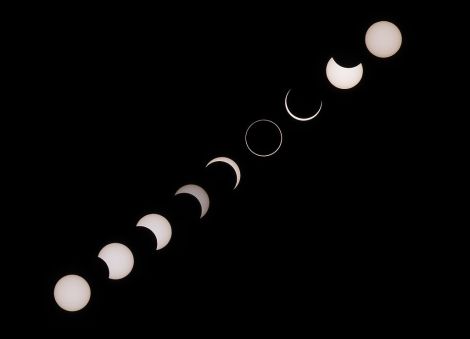
Time lapse photos of a total solar eclipse. By Scoolasse (Own work). Used under a CC BY-SA 4.0 license (http://creativecommons.org/licenses/by-sa/4.0) via Wikimedia Commons
This brings us to the question of how to best view an eclipse, or more specifically how to help our children observe the eclipse. Looking directly at the sun without protection, even during an eclipse (maybe especially during an eclipse) is dangerous and will damage your vision. Given how important we all know vision is, and how much we’ve invested in our children’s vision, I’ve seen a lot of questions about what to do for safety.
I talked with Dr. Nate Bonilla-Warford, a pediatric optometrist in Tampa, FL about his thoughts on children viewing the eclipse. He said:
“An eclipse is an exciting event for the entire family. As long as you and your children are prepared ahead of time with proper viewing equipment, practice, and instruction to never look directly at the sun, there is very low risk of eye problems. If you are concerned about vision problems after the eclipse, vision your eye doctor.”
You can hear more from Dr. Nate on his recent podcast, about eclipse safety.
There are safe and not-safe ways to observe the eclipse
As mentioned before, looking at the sun without protection will damage your child’s eyes (and your eyes). Usually, the brightness of the sun keeps you from looking directly at it, however, during the eclipse, the sun will be less bright and it may feel more comfortable to look at the sun. The backs of our eyes do not have pain sensors, so there’s not any feedback telling you to look away. And unfortunately, looking directly at the sun can cause permanent damage known as solar retinopathy.
For any eclipse viewing, make sure that you supervise your child and that you emphasize to them how important it is that they not look directly at the sun. You know your child best, if they are likely to try to stare at the sun, maybe directly observing the eclipse outside isn’t the right activity for them (there are other ways to observe it though).
Observing the eclipse without looking at the sun
Some of the best ways of observing the eclipse don’t involve looking directly at the sun at all.
Pinhole projectors
Making a pinhole projector is easy and it lets you see the changes in the sun during the eclipse safely as you are looking at a projection of the sun.
NASA has a page with instructions and printable pdfs to use to make different pinhole projectors at home.
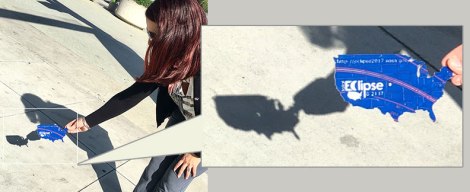
One of the pinhole projector projects from NASA http://eclipse2017.nasa.gov/2d3d-printable-pinhole-projectors
University of Illinois has instructions to make a couple of different types of viewers, from cereal box or a cardboard tube.
Looking at shadows cast by leaves
This is my favorite! The sun shining through leaves on the trees makes a natural pinhole projector – you can see the shape of the eclipse in the shadows. This made a huge impression on me as a child and I still think of it every time I look at shadows of leaves.
The science blog, Last Word on Nothing has a great explanation of this.
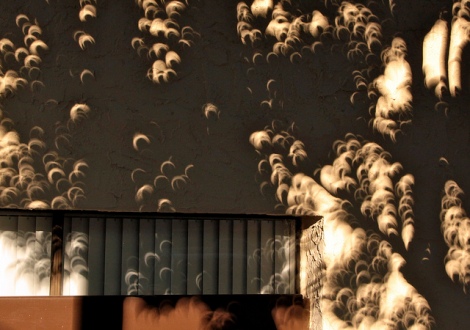
Tree shadows as a natural pinhole viewer during the eclipse in San Francisco in 2012. Photo credit: torbakhopper, https://www.flickr.com/photos/gazeronly/7243724172. Used under a CC BY-2.0 license.
If you live near an observatory, many will have public events (though they’ll probably be very crowded) and many will have other solar viewers that let you view the eclipse safely, often in much greater detail than you’d be able to see on your own. Plus, there will be astronomers and teachers there to give you more information during the event.
Using Eclipse Glasses
I’ve saved this section for the last, since I think this is potentially the most likely viewing method to lead to problems.
First, it is critical to make sure that the glasses you have are compliant with the ISO 12312-2 international safety standard (read more about this on the NASA site). If they are the right kind of glasses, you will not be able to see through them at all when you aren’t looking at the sun.
For kids who wear glasses, the eclipse glasses should go over their regular glasses. It may be easiest for them to just hold the glasses up to their eyes rather than try to wear them over their glasses. Try this out before the eclipse.
You can cut out a paper plate around the glasses to make them easier for your child to hold up to their eyes and make it less likely that they’ll peek around at the sun. The blog, Do it on a Dime with Kathryn, has detailed instructions.
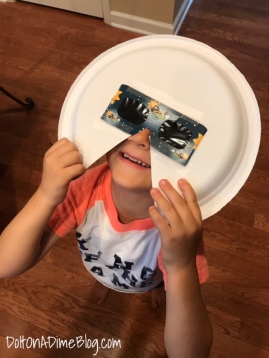
Eclipse glasses with paper plate holder. From http://www.doitonadimeblog.com/2017/08/2017-solar-eclipse-for-kids/
Again, make sure you are supervising your child while they use the glasses and make sure that they are not looking at the sun without them.
Watch online or on tv
If the weather doesn’t cooperate or you feel that this isn’t something your child can do safely, the eclipse will – of course – be broadcast through a lot of different channels live, both on tv and online.
Have a wonderful and safe eclipse!
Eclipse information and safety links:
Safety:
Pinhole projectors:
- 2d and 3d printable pinhole projectors from NASA
- Jet Propulsion Laboratory’s instructions on making a pinhole camera
- University of Illinois’ instructions on making pinhole projectors
- A photo gallery of shadows from trees during eclipses
- More explanation of the pinhole effect from leaves and other shadows
Making a holder for your child’s eclipse glasses:
Viewing the eclipse online or on tv
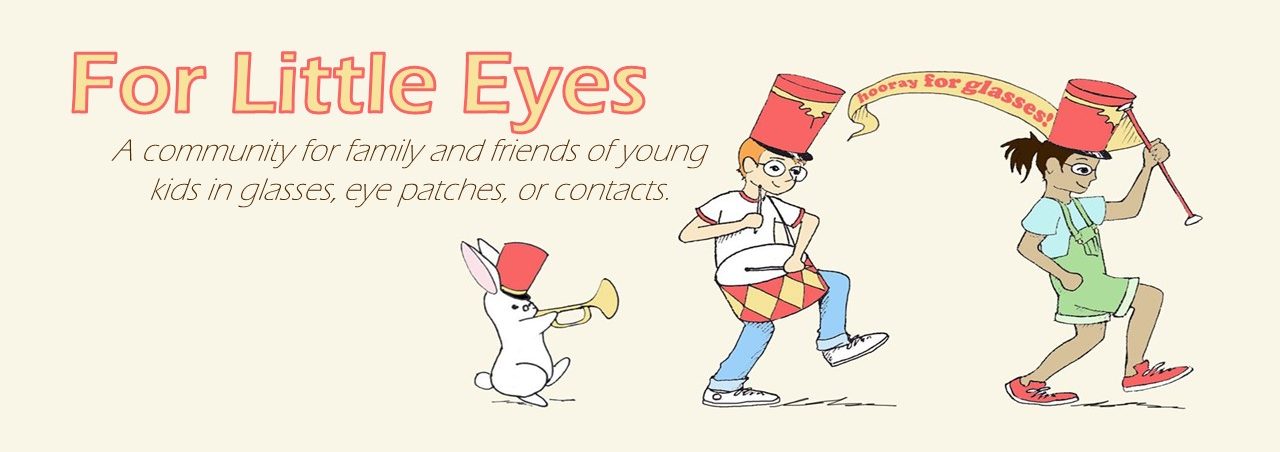
Pingback: Podcast Episode #5: Eclipse Safety·